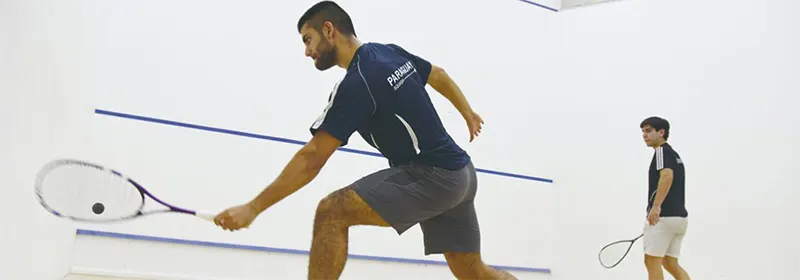21 August 2022 / 3-Min Read / Translate
In general, after you have hit the ball, you should move to the T as fast and as smoothly as possible. But when it’s your turn to hit the ball, you should move to the ball as fast as needed.
One of the very common mistake new players make when first playing games and matches, as opposed to just practising, is that they hit the ball and unless the ball is coming back to where they are standing, they often remain still and watch their shot. They haven’t yet developed the muscle memory of “Hit and Move”. It needs to become a habit: done without even thinking about.
Knowing exactly where the T is, is very important: How can you get back there if you don’t know where it is! But that’s only half the knowledge needed. You also need to know how to move. Depending on the type of shot played, the followthrough can be used as momentum to begin your movement back. This works best out of the back corners, and the smooth sideways steps, that get you back to the centre line and then a fast walk to the T is beautiful to watch when done well, especially if both players are rallying to the back.

One area of the court that produces very different movement patterns between advanced squash players and club squash players is the front of the court. Advanced squash players will mostly move backwards, with their chest facing the front and their head turned to watch their opponent. They do this to ensure that returning to the front or going to the back is as easy and fast as possible.
Lower level players, will often spin and move forwards from the front of the court back to the T area thinking it’s the fastest way, not realising that if the ball is hit to anywhere except the opposite corner they will have to perform some sort of spin to reach it.
The first way is ghosting. I’ve talked about the best way to improve your footwork in a previous article and promise to write a proper one on ghosting soon, but essentially ghosting is pretending to play a game of squash on your own and moving about the court. It can be done for fitness or technique. The “problem” with ghosting is that unless you are doing it correctly, you might be forming bad habits that will be difficult to break and replace with good ones. So, before you do lots of ghosting, see a coach to ensure you will be practising and improving the correct way.
The other way to develop good movement habits is Conditioned Games. A conditioned game is one that limits what you are allowed to do: That’s the condition. For example, your shots must bounce past the short line. This game helps develop better length shots AND better movement around your opponent. It does this because both players know more or less where the ball is going and you have to move out of the way that allows them direct access to the ball, but also gives you the maximum chance to cover their return.
A couple of days ago, I wrote about squash mantras and if you suffer from slow movement back to the T, perhaps you can adopt the simple mantra of “Hit and Move”. In fact, it’s not the first time I have written about this topic.
Good movement is as much about physical fitness and technique as it is about habits. Develop movement habits that give you flexibility to change direction as quickly as possible.